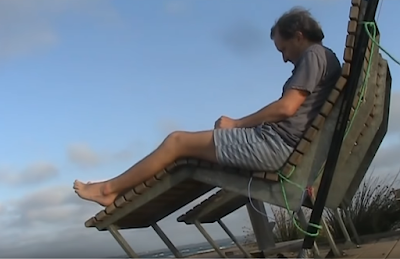It's heading towards summer in the northern hemisphere. Beach weather. What if you want to operate from there? After all the proximity to salt water improves signals, and if you're away from urbanised areas you'll benefit from lower local noise as well.
One problem is that if the weather is nice the beach will be popular. With other people around. So you don't want to take too much space, have people (and dogs!) trip over your antenna radials or make too much noise. Careful selection of antennas takes care of the former while CW (with headphones) and the more efficient digital modes look after the latter.
The most important thing is not radio-related at all. It's to find a seat that's comfortable for you. After all you could be operating from there for an hour or more. I particularly like the seat pictured above. Whereas (for me) the curves in the one below make it so uncomfortable that I prefer being on the ground.
Then there's the antenna. It will almost certainly be some sort of vertical. A magnetic loop could work but it may be unwieldy. And it will require frequent adjustment if changing the frequency. An extendable pole with some sort of vertical is elegant and takes up next to no horizontal space. And you may be able to tie it to your seat.
Possibilities include an end-fed vertical with an L-match antenna coupler. A 9 metre pole will allow one that's close to a half wavelength long on 14 MHz. Or you could try a vertical dipole. A difficulty with that is ideally you need to bring the feedline away from the dipole's centre. Or you could try a coaxial type vertical dipole where the lower element surrounds the coaxial feedline.
If there's a support (eg a sign) that's 10 or 15 metres away you could tie off a wire there. Then you could use an inverted-L about 20 metres in total length. That will work well on popular bands like 7, 10 and 14 MHz. And likely higher. This is what I used in the video below to work CW and SSB USA DX from Australia. A horizontal dipole or inverted vee is also good but you'll need two supports apart from the central pole.
Grounding is another consideration. Your seat may have a metal frame. That could be clamped onto (picture below). However that won't be big enough for the lower HF bands. Radials present a trip hazard but if there's a timber deck you might be able to have them underneath. Or even under sand if right on the beach. Though dogs are guaranteed to dig so be prepared for them to be uncovered.
What about VHF/UHF? A small yagi for 144 or 432 MHz is light enough to be supported on a fishing pole. Provided it's 3 or more metres up it won't get in anyone's way. And, even though it's not far above sea level, the water side location may be favourable for tropospheric ducting as often happens over summer.
These are a few ideas for operating from a beach seat. Have you done it? What's worked for you? Please share your experiences below.
PS: Want to support The Daily Antenna?
You won't be charged extra and I'll get a small cut from any purchases you make (affiliate link). You can buy lots of stuff there, including electronic parts and my books.








No comments:
Post a Comment